Birla Sun Life Advantage Fund Invest Online

Over the past few months, we have seen headlines like "2 times return in 3 years" from some equity mutual funds. While the performance of these fund managers should certainly be lauded, one must also remember that the equity market has been mostly favourable over the past 3 years. There are a few funds which have stood the test of time and have given stellar returns over a long time period that included both bull and bear market cycles. Birla Sun Life Advantage Fund is certainly one of these funds. The fund recently completed 20 years of strong performance. र 1 lac invested in this fund 20 years back would have grown to nearly र 37 lacs by now. The chart below shows the trailing annualised returns of Birla Sun Life Advantage fund versus BSE 200 benchmark index, over the last 1 year, 3 years, 5 years and 10 years time periods.
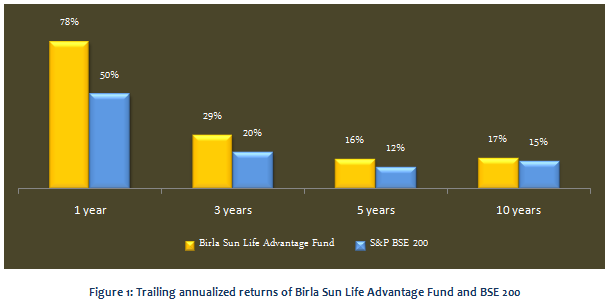
Fund Overview
Birla Sun Life Advantage Fund, a diversified equity fund, was launched in February 1995. The fund's relatively modest AUM base of around र 440 crores notwithstanding, the fund has given nearly 20% compounded annual return since inception (based on NAV as on March 3 2015). The expense ratio of the fund is slightly on the higher side at 2.85%. The fund is managed by Satyabrata Mohanty. Other funds managed by Satyabrata have also given good returns over the past 3 years. The chart below shows the annual returns of the Birla Sun Life Advantage Fund from 2004 to 2015 YTD. While the fund lagged behind the BSE 200 index from 2006 to 2011, the fund performance picked after 2012 and the fund is now outperforming the benchmark index.
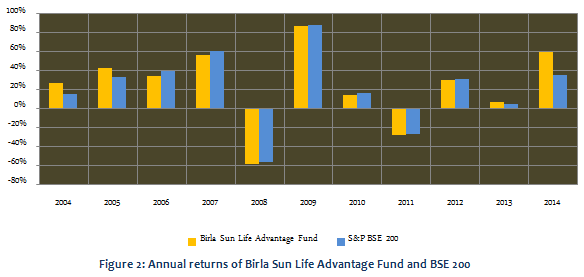
Portfolio Composition
The fund portfolio is evenly balanced between large cap stocks and small / midcap stocks. Large cap stocks comprise nearly 50% of the fund portfolio, while midcap and small cap stocks comprise another 50%. In terms of sector allocation, the portfolio has a heavy bias towards cyclical sectors like Banking and Financial Services, Automobiles and automobile ancillaries, Engineering, Cement and Construction etc. With cyclical sectors poised to do well when economic growth and investment cycle revives, the Birla Sun Life Advantage fund is positioned strongly to do well in the near to medium term. In terms of company concentration, while the top 5 companies comprises mostly banks, the fund portfolio is fairly well diversified with the top 5 holdings accounting for only 25% of the total portfolio value. Even the top 10 company holdings account for a little over 40% of the total portfolio value.

Risk and Return
In terms of risk measures, the standard deviation of monthly returns of the Birla Sun Life Advantage Fund is 17.7%, which is slightly on the higher side compared to the category of diversified equity fund. However, in terms of risk adjusted returns, as measured by Sharpe ratio the fund has outperformed the diversified equity funds category.
र 1 lac lump sum investment in the Birla Sun Life Advantage Fund (growth option) 10 years back would have grown nearly 5 times in the last 10 years. The chart below shows the growth of र 1 lac investment in the Birla Sun Life Advantage Fund (growth option).
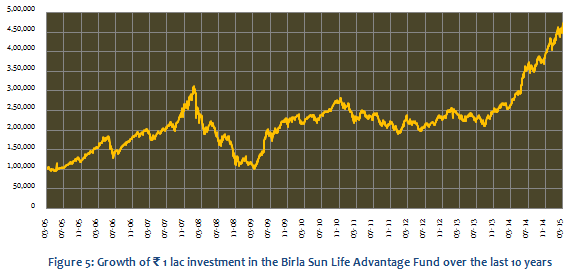
The chart below shows the returns over the last 10 years of र 3,000 invested monthly through SIP route in the Birla Sun Life Advantage fund (growth option). The SIP date has been assumed to be first working day of the month. The chart below shows the SIP returns of the fund. NAVs as on March 3 2015.
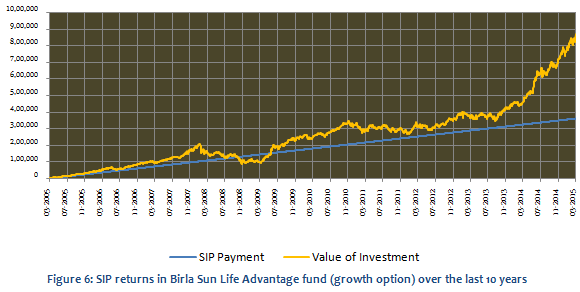
The chart above shows that a monthly SIP of र 3,000, started 10 years back in the Birla Sun Life Advantage fund (growth option) would have grown to over र 8.7 lacs by December 5 2014, while the investor would have invested in total only about र 3.6 lacs. The SIP return (XIRR) is nearly 17% over the last nearly 10 years.
Dividend Payout Track Record
Birla Sun Life Advantage Fund, Dividend Option has a strong dividend payout track record. The dividend option has paid dividends every year for the last 10 years, except 2006 and 2007.
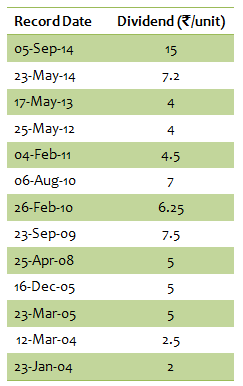
Conclusion
Birla Sun Life Advantage fund has completed 20 years of strong performance. It has created wealth for its long term investors. This fund is suitable for investors looking for high capital appreciation over a long time horizon, for long term financial objectives, such as retirement planning, children's education etc. Investors looking for regular dividend payments can also invest in the dividend option of the fund. Investors can consider investing in the scheme through the systematic investment plan (SIP) or lump sum mode with a long time horizon. Investors should consult with their financial advisors, if Birla Sun Life Advantage Fund is suitable for their investment portfolio.
Top 10 Tax Saving Mutual Funds to invest in India for 2016
Best 10 ELSS Mutual Funds in india for 2016
1. BNP Paribas Long Term Equity Fund
2. Axis Tax Saver Fund
3. Franklin India TaxShield
4. ICICI Prudential Long Term Equity Fund
5. IDFC Tax Advantage (ELSS) Fund
6. Birla Sun Life Tax Relief 96
7. DSP BlackRock Tax Saver Fund
8. Reliance Tax Saver (ELSS) Fund
9. Religare Tax Plan
10. Birla Sun Life Tax Plan
Invest in Best Performing 2016 Tax Saver Mutual Funds Online
For further information contact Prajna Capital on 94 8300 8300 by leaving a missed call
---------------------------------------------
Leave your comment with mail ID and we will answer them
OR
You can write to us at
PrajnaCapital [at] Gmail [dot] Com
OR
Leave a missed Call on 94 8300 8300
-----------------------------------------------